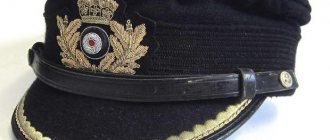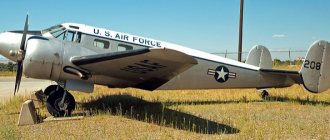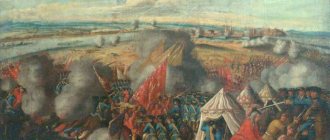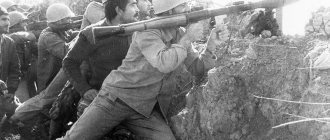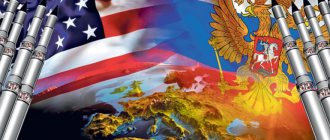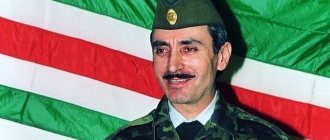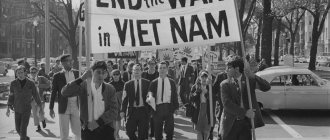11.07.2014
US Airborne Forces
Our online store Voentorg “Voenpro” devotes a lot of time to studying and analyzing the equipment and paraphernalia of the armed forces of the armies of different countries. First of all, of course, we write most about our native army, open a broader view of it, and popularize it among the masses. But we must not forget that there are other objects for study in the world. On the eve of Airborne Forces Day, we decided to move somewhat away from the topic of domestic paratroopers and talk about their overseas opponents - the US Airborne Forces.
You shouldn’t treat a potential opponent laxly, but you need to know as much as possible about him. But the American Airborne Forces are considered one of the strongest and most combat-ready units of the local army. Just like with us, the best soldiers of their country serve there, ready to go off to fulfill their army duty at the first call of the command. First of all, the text will contain information about the two most historically famous American airborne divisions - the 101st US Airborne Division and the 82nd US Airborne Division. So let's get started.
Features and differences between the American Airborne Forces and their Russian “colleagues”
All airborne divisions of the American Airborne Forces are included in the XVIII Airborne Corps. If in the Russian army airborne units are separated into a separate branch of the military, then the Americans consider their airborne units as an integral component of the ground armies. However, this does not prevent us from providing units of the US Airborne Forces with truly excellent combat training, because the local airborne units are considered the most prepared unit for the fastest response.
American paratroopers performed well during Operation Enduring Freedom. By the way, in the assortment of our military store you will find many unique award badges and emblems of US special operations forces dedicated to the war in Afghanistan and other conflicts.
Therefore, the Airborne Corps, which includes units of the American Airborne Forces, is somewhat similar in structure to a small army that can attack, deploy in a certain territory and immediately gain a foothold on it in order to prepare a bridgehead for the next offensive or hold already occupied territories.
The US Airborne Forces have extensive combat experience and have their own historical traditions. If more, then the airborne troops of the United States are one of the oldest units of the mass American army, not counting, of course, the infantry. If we take as the point of formation of the mass US army not the years of the Civil War, but the entry into the First World War, then it becomes clear that the American Airborne Forces become a detail, without which it is difficult to imagine the construction of a modern army, even one hundred years ago.
82nd US Airborne Division
It was during this period that the oldest American airborne division was formed - the 82nd US Airborne Division. Despite the beginning of its formation only in March 1917, it managed to take part in the First World War in the final phase of the offensive operations of 1918. The 82nd US Airborne Division has a curious nickname - “All-American”.
The thing is that at the time of the formation of the division’s personnel, it turned out that it included representatives of all US states, of which there were 48 at that time. As a tribute to the memory of this nickname, the letters AA are present on the chevrons of the 82nd US Airborne Division.
Subsequently, after World War I, the 82nd US Airborne Division was demobilized, but with the outbreak of a new world conflict it returned to active service. After 1945, this division was one of the few military formations that was not disbanded with the end of the war. The 82nd US Airborne Division had a special strategic status - it was then that it began to form as a maximum response division. Its members did not participate in the Korean War, were practically not in Vietnam, but fought in the Dominican Republic, Panama, Kuwait, Iraq, and Afghanistan.
Today, the 82nd US Airborne Division is absolutely the only unit in the entire US armed forces that is designed for parachute landing. In principle, this is normal, since the US rapid reaction forces do not need an excessive number of parachute formations, and the 82nd US Airborne Division, in cooperation with the ground units of the Airborne Corps, copes with its tasks at a good level.
US 101st Airborne Division
Also, another significant part of the American Airborne Forces is the 101st US Airborne Division - probably one of the most famous American divisions in the world. Its name is often found in movies (for example, “Saving Private Ryan”) and computer games, and fans of rock musician Jimi Hendrix know that for some time he served in the 101st US Airborne Division.
This division of the American Airborne Forces was formed as a result of the creation of new units of the US Army during World War II. It so happened that the 101st division of the US Airborne Forces during its existence - 72 years without taking into account the almost 5-year disbandment - managed to take part in the hottest world conflicts with the participation of the United States. Normandy, Market Garden, counter-offensive in the Ardennes, the Vietnam War, Desert Storm, Afghanistan, the overthrow of Saddam Hussein - everywhere the 101st US Airborne Division was in the lead. Obviously, this explains why she is so famous all over the world.
Nowadays, the 101st US Airborne Division is traditionally called the airborne division, although it would be more correct to call it air assault, since the landing does not take place by parachute, but by landing on special transport helicopters, usually of the BlackHawk type.
Of course, airborne units in the United States are not limited exclusively to the 82nd and 101st US Airborne divisions. The Airborne Corps includes standard infantry units, artillerymen of various directions, a mountain division, an air support brigade, and logistics units, and on top of that, the corps, if necessary, can be reinforced with an armored division. In general, the US Airborne Forces have all the necessary resources to conduct maximum operational combat operations at a given point.
Standard weapons of the American landing force
With the weapons of the American paratroopers, everything is also up to par. In addition to standard rifles, carbines, submachine guns, there are also special landing equipment, such as light combat vehicles armed with 105 mm guns, 155 mm artillery howitzers, and multiple launch rocket systems. And, of course, each paratrooper of the US Airborne Forces has his own equipment and equipment, which is not limited exclusively to military weapons.
It is also worth noting that units of the US Airborne Forces are used not only for military purposes. When a powerful earthquake occurred in Haiti in 2010, almost breaking the island, it was parts of the US Airborne Forces that were sent to help the victims, as the most operational unit, in order to help in searching for missing people, in evacuating people from the affected regions and protecting them from looting. Also, parts of the American Airborne Forces were used for the same purposes after Hurricane Katrina.
So, the US Airborne Forces are suitable not only for war, but also for ordinary life, in which nature is and will continue to be omnipotent.
← Armament of the Russian Airborne Forces Songs of the Airborne Forces in Chechnya and Afghanistan →
From the sky to the ground: “Landing” jumped to the point of injury
Let's start with the fact that there are no airborne forces in the USA. American airborne troops, unlike Russian ones, are not a separate branch of the military, but are part of the ground army contingent. The most famous are the 82nd Airborne Division and the 101st Airborne Division. The 25th Infantry Division has an airborne brigade. For the most part, the US Army prefers to deliver paratroopers to their destination by air - on airplanes and helicopters; parachute drops are used extremely rarely. Mass parachute landings, which have become widespread in the Russian army, are not used at all.
The Russian airborne forces have certain standards for parachute jumps. For generals, including the commander of the Airborne Forces, two per year is enough. Previously, a conscript soldier, like a junior officer, was assigned six, but now the standard for a private has been raised to twelve due to a reduction in service life. This is according to the standards; during service you have to jump with a parachute much more often, including during exercises. This involves landing in difficult conditions - landing on water, in forests and at night. The last one is the most unpleasant.
According to a message from an official representative of the 25th US Infantry Division, 22 American paratroopers were injured during parachute jumps near the Camp Shelby base in Mississippi at night. Some of the 80 landing troops landed in trees. There was an obvious mistake by the pilots of military transport aircraft during the airdrop, plus a side wind that blew the paratroopers away from the main landing site into the forest. There were no casualties, but the case is quite indicative of the lack of a sufficient degree of professionalism.
Armament of American paratroopers
During World War II, whether behind enemy lines or during battles on the front lines, American paratroopers trusted their lives to rifles, pistols, submachine guns and automatic rifles.
Like most armies around the world, paratroopers were among the elite forces of the United States and distinguished themselves in a number of large-scale operations, such as the Siege of Sicily, the Normandy landings, Operation Market Garden, and also took part in military operations in the Pacific Ocean. By the end of the war, the American army had formed several active airborne divisions, the strongest and most equipped in the history of wars.
Before the events at Pearl Harbor, the same departments that dealt with the ground forces were responsible for equipping paratroopers with weapons. The active involvement of the United States in the Second World War entailed a significant expansion of the types of weapons of the paratroopers, although the basis of the system was still infantry models and their modifications.
COLT M1911A1 PISTOL
The paratroopers used the standard M1911A1 .45 caliber (.45 ACP), which was in service with the infantry. Moreover, the pistol was part of the equipment of almost every paratrooper - even in the event of the loss of the main weapon, the pistol was always at hand.
During the Second World War, both modern improved pistols and models produced on the eve of the war, during the First World War and even earlier (M1911) were used.
Depending on individual preferences, paratroopers made limited use of six-shot Smith & Wesson .45 1917 and Colt .45 1917 revolvers. Both models used .45 ACP pistol cartridges, which were inserted into the drum using three-round plate clips. The commercial .45 Auto Rim, a rimmed .45 ACP cartridge, was used in these clipless revolvers.
RIFLE M1 GARAND
The M1 Garand self-loading rifle, adopted for service back in 1936, was supplied to the active army in small quantities at the beginning of the war. Until 1943, only a small part of the infantry was armed with the Garand. The basis of the armament was the M1903 Springfield repeating rifle with a longitudinally sliding bolt. From the very beginning of the war, paratroopers preferred the M1 rifle, since the firepower and comparative lightness of the model met the basic requirements of this type of troops. The M1903 rifle was used to a limited extent, mainly for throwing rifle grenades (Granad'e launching platform), and the M1 Garand was the main weapon in almost all landing operations.
It must be said that this rifle also had disadvantages - first of all, its large dimensions and weight (about 4.5 kg), which did not fully meet the requirements of the paratroopers.
To protect the rifle during the landing, a specially designed case called the Griswold Bag was used. For compactness, the rifle was disassembled and placed in a case without a butt, and after landing, the paratroopers assembled the rifle. Despite its convenience, the Griswold Bag was not always used. Many paratroopers jumped with pre-assembled rifles so as not to waste time on the ground assembling them.
The M1 rifle earned a good reputation both among paratroopers and among the ground forces in terms of reliability and firepower, it was considered the best.
US MARINE LANDING UNITS
World War II US Marine paratrooper with a M55 Raising submachine gun
Although the most famous are the Army parachute units, the US Marine Corps also formed several small (battalion-sized) parachute units shortly before the Japanese attack on Pearl Harbor. Only volunteers who had undergone serious jumping and special training served in them. Marine paratroopers are sometimes called Para Marines.
Despite the fact that Marine paratroopers did not take part in operations related directly to landing, they were used in combat operations in the Solomon Islands and throughout the Pacific theater of operations.
The most important element of the weapons of the Marine Corps paratroopers were submachine guns. At the very beginning of the war, the Reising M50 PP was adopted by the Marine Corps. This was mainly due to a shortage of standard M1928 submachine guns. At the beginning of the Second World War, "Raising" was widely used in the Marine Corps, especially during the operation on Guadocanal. The Reising was a fairly light and accurate weapon. The shot took place with the shutter closed.
The Raising 55 model differed from the M50 in the presence of a folding wire stock and the absence of a compensator. This was done in order to reduce the size of the weapon and maximize its adaptation to landing conditions. The M55 was issued to all Marine Corps parachute units.
Although the Raising performed well on the shooting range, when used in combat, the system experienced delays in firing with alarming regularity. During the operation on Guadocanal, a large number of these anti-tank missiles were removed from the armament of active units due to their tendency to delay. As the number of other SMGs grew (including Thompson), Reisings were withdrawn from the troops, and by the end of the war there were no longer any of them left in the units.
To increase firepower, the airborne units were armed with a large number of Johnson M1941 light machine guns (Model of 1941 Johnson Light Machine Gun). In addition, Marine Corps parachute units used a limited number of M1941 Johnson self-loading rifles.
As the war progressed, US Marine Corps paratroopers also “mastered” purely army models: M1 self-loading rifles, BAR automatic rifles, and M1A1 carbines.
After the disbandment of the First Parachute Regiment, Para Marines units were absorbed into other units of the United States Marine Corps.
Today, the history of these parachute units is sometimes mentioned when talking about American elite units of the Second World War.
CARBINES М1.30-CAL AND М1А1.30-CAL
The .30 caliber M1 carbine was adopted in 1941 as a weapon that was intended to replace the pistol and submachine gun. During the Second World War (from late 1941 to mid-1945), this carbine (including modifications) was produced in quantities of more than 6,000,000 copies - significantly more than any other American-made small arms. Thanks to its compactness, lightness and rate of fire, the carbine quickly took root in the landing force.
Self-loading carbine М1А1.30-Cal
In addition to The Winchester Repeating Arms Co., which is the developer of the design, 9 other companies received the right to manufacture the M1 and produced it during the war.
In order to maximally adapt the M1 to the specific operating conditions of airborne troops, at the beginning of the war it was decided to develop a special modification.
The carbine was modified by General Motors, the main manufacturer of the base carbine.
As a result, he received a pistol grip and a metal butt that folded onto the left side. The new model was named M1A1.
The M1A1 self-loading carbine differed from the M1 in the presence of a folding metal stock and a pistol grip fire control. A pencil case with accessories for cleaning and lubrication was attached to the butt
This version of the carbine was adopted in May 1942 under the name Carbine Cal. .30, M1A1. Already in the summer of the same year, deliveries of M1A1 began to the 82nd and 101st Airborne Divisions of the US Army.
In total, before the adoption of a new type of weapon in December 1944, the General Motors Inland Manufacturing Division produced 140,590 M1A1 carbines.
It should be noted that the M1A1 carbine was the only weapon model developed specifically for paratroopers and, along with a small number of M1s, took part in all landing operations of the Second World War.
After the war, the M1 and M1A1 carbines remained in service with the US Army for a long time. Most of them have been modernized and supplemented with modern components.
Nowadays it is very difficult to find the original version of the carbine. Each surviving copy is highly valued by collectors.
M1928A1, M1 AND M1A1 THOMPSON submachine guns
Firepower is the main requirement for weapons during amphibious operations. Along with the M1 self-loading rifle and .30 caliber M1 series carbines, submachine guns were widely used by American paratroopers during World War II.
The main submachine gun of the American armed forces at the beginning of the war was the famous M1928A1 Thompson .45 caliber.
Before the outbreak of World War II, when forming parachute detachments, the Thompson submachine gun was considered the most suitable weapon for paratroopers. Despite the fact that the PP was expensive and heavy, it provided the necessary firepower, was durable and reliable. The PP cartridges could be fed from both a 50-round disk magazine and a 20-round box magazine.
M1A1 self-loading carbine and M1928A1 Thompson submachine gun with a box magazine for 30 rounds
After 1943, paratroopers abandoned disk magazines due to their large mass, noise and difficulty in using. In the late period of the war, a magazine with a capacity of 30 rounds was developed, which, due to its versatility, immediately became widespread.
At the beginning of the war, the M1928A1 was produced by The Auto Ordnance Corp. and The Savage Arms Co. Due to high production costs, unacceptable for wartime, a simplified version was developed - modification M1. This model was very different from the M1928A1: the muzzle brake compensator disappeared from the barrel, the low-tech and not always necessary Lyman sight was replaced by a stamped metal rear sight, the cocking handle from the top of the receiver moved to the right side. Other differences include a non-removable stock and a modified receiver design, which no longer allowed the use of a disc magazine.
The trigger disappeared from the design of the firing mechanism. The primer was punctured by a striker rigidly fixed in the bolt cup. The final version of the PP was called M1A1.
The production of modifications M1 and M1A1 required significantly less money and time than the production of M1928A1. But during the war, all variants of the Thompson were widely used.
Many paratroopers preferred the Thompson over other models for its firepower and durability.
M3 AND M3A1 submachine guns
Although various versions of the Thompson were popular in the army, the production of even simplified versions required considerable funds and time. In this regard, the issue of adopting a new model was not resolved, and gunsmith designer George Hyde developed a simple and technologically advanced submachine gun chambered for .45ACP. After modification, the PP was adopted for service under the name Submachine Gun, Caliber .45, M3. The M3 was informally called a grease gun by the military because of its resemblance to a mechanic's tool.
Stamping was widely used in the manufacture of M3. The right to produce this model belonged to General Motors - The Guide Lamp Division.
With its appearance, the M3 upset many American military personnel, who preferred the familiar and well-proven Thompson.
M3A1 submachine gun
Among the first victories involving the M3 was the Normandy landing. During the Second World War, the M3 did not have time to gain widespread popularity. For example, the paratroopers of the 82nd (All Americans) and 101st (Screaming Eagles) divisions were armed with Thompsons during the landing in France.
In the last years of the war, an improved version of the greasy gun was adopted by the army under the name M3A1.
The cocking handle disappeared from the M3A1 design. Instead, a groove appeared on the bolt, which allowed the weapon to be cocked with a finger.
After the war, the M3A1 replaced the Thompson and became the main submachine gun of the American army, and a small number of M3A1s are still used in it.
AUTOMATIC RIFLE BAR (BROWNING AUTOMATIC RIFLE)
During World War II, the US Army's primary branch automatic weapon was the venerable Browning Automatic Rifle (BAR). Despite its large mass (9 kg), this rifle was a reliable weapon and was used not only in the infantry, but also in the airborne forces, where it was the only automatic support weapon providing the necessary firepower.
The rifle used .30-06 Springfield cartridges - the same as the M1 self-loading rifle and the M1903 magazine. The cartridges were fed from a 20-round detachable magazine. To improve the accuracy and accuracy of fire, special bipods could be used, but paratroopers most often did without them, preferring not to overload themselves with excess weight.
Bruce N. Canfield
Light tank for the US Airborne Forces
In December 2022, BAE Systems presented the final appearance of the M8 light tank for US airborne troops. What is M8? And why did the airborne divisions of the American army need a light tank? Read our material.
In the 80s of the twentieth century, the US Army was faced with the problem of obsolescence of its main light airborne tank, the M551 Sheridan. After the not entirely successful combat operation of this combat vehicle during the Vietnam War, the Sheridans began to be gradually withdrawn from service and settled in long-term storage warehouses. Thus, the airborne troops were left practically without tanks.
Soon, the US Department of Defense began the Armored Gun System program, the goal of which was to create a light combat vehicle armed with a 105-mm cannon and the ability to be transported on a C-130 transport aircraft. Three companies participated in the development of such a machine: Cadillac Cage Company, Teledyne Continental Motors and Food Machinery Corporation. Subsequently, the Cadillac Cage Company was able to develop and present its Stingray tank, which did not enter service with the US Army, but had some export success in the form of the delivery of 106 units of these combat vehicles to the Thai troops.
Teledyne Continental Motors created a very unusual tank for those times with a front-mounted engine compartment and a remote-controlled main combat module in the form of a 105 mm gun. This combat vehicle received an unofficial name as TCM-20, where the letters denoted the abbreviation of the developer’s company.
However, this sample of equipment did not impress the American military; they settled on a more classic version of the tank, which was offered to them by the Food Machinery Corporation. Subsequently, already in the 90s, their combat vehicle would be named M8, and the United Defense company would be created for further work on the tank.
Main characteristics of the M8 light tank:
Combat weight - 17.5 tons (1st level protection); 20.2 t (2nd level protection); 22.5 t (3rd level protection) Crew – 3 people Gun – 105 mm rifled EX-35 Ammunition – 30 rounds Ammunition types: BPS, BFS, BKS, FS, DS, SGPE Range finder – laser Weapon stabilizer – 2- x planar Ballistic computer - electronic digital Loading - automatic Machine guns - one 12.7 mm; one 7.62 mm Armor protection - against small-caliber projectiles and bullets of all calibers Maximum speed - 74.4 km/h Cruising range (at an average speed of 40 km/h) - 480 km Engine - diesel 6V-92 TA Detroit Diesel Engine power – 426 kW Transmission – hydromechanical with GOP in the main and auxiliary drives Suspension – individual torsion bar with hydraulic shock absorbers Caterpillar – with parallel-type RMSh Fording depth – 1.32 m (with preparation)
The M8 is a combat vehicle with a classic crew arrangement, the driver is located in the front of the hull, the commander and gunner are on the right side of the turret, while the left side houses the automatic loader and 21 rounds, separated from the fighting compartment by a partition. The remaining 9 ammunition are located separately in the tank and are loaded manually by the crew. The shells are sent to the cannon in five seconds. If the automatic ammunition feeding system fails, the ammunition can be loaded manually. On the left and right sides of the gun there are 8 mortars for shooting smoke grenades. The machine gun paired with the main gun has 2,700 ready-to-fire rounds and another 1,800 in storage. The roof-mounted heavy machine gun can be replaced with an automatic grenade launcher. The number of rounds for an anti-aircraft machine gun is 600, of which 100 are loaded.
The tank commander and gunner have displays on which the fields of view of the sights can be mutually displayed, which allows the use of the fire control system in the mode of simultaneous search and destruction of targets. At the customer's request, night vision devices can be installed in the tank. The tank has an automatic fire extinguishing system and protection against weapons of mass destruction.
The M8 has aluminum armor that can be upgraded in three stages. In the first version, the tank has protection similar to the Bradley infantry fighting vehicle, all-aspect protection from small arms, including large-caliber weapons in the frontal projection, and can be parachuted from transport aircraft using parachute systems. The second level of protection strengthens the tank with additional metal armor, but makes it impossible to parachute from aircraft. The third level of protection, in addition to the installation of additional armor, provides for the placement of dynamic protection, however, in this form, transportation of the M8 by C-130 transport aircraft was impossible, and required a heavier C-17, which could take on board three such vehicles or a C-5, on board which five tanks could be accommodated.
To a large extent, the M8 outperformed its competitors in that many of its components were already in mass production, thereby reducing the cost of the tank. Thus, the 6V-92 TA engine was used on the M977 heavy truck, the transmission and manual guidance drives for the commander and gunner were similar to those in the Bradley infantry fighting vehicle, the laser rangefinder and side wind sensor were used in the Abrams tank, and the ballistic computer panel in Challenger MK2.
In the early 90s, about six M8 prototypes underwent army testing at various training grounds. It was assumed that as soon as the combat vehicle was put into production for the needs of airborne troops and a number of armored cavalry units, from 250 to 300 light tanks would be purchased, after which the Pentagon could well sign additional contracts for the supply of these tanks to the troops. However, these plans were not destined to come true. In the 90s, the Cold War ended, and with it the arms race, funding for the US Army fell sharply, a number of programs were closed, one of them was the program for the development and purchase of light tanks. As a result, already at the end of the tests, the M8 was no longer needed by the army for which it was created. It was also not possible to sell a ready-made combat vehicle for export. No country was interested in the light airborne tank. The Stingray, which could not land by parachute, but was superior to the M8 in a number of other characteristics, turned out to be more preferable in the role of an export combat vehicle.
In the early 2000s, several M8 prototypes were proposed to be transferred to the 82nd Airborne Division for military operation of the tank. It was assumed that the military would still be interested in this combat vehicle. However, the M8 never reached the paratroopers, since the M1128, a version of the Stryker armored personnel carrier with a 105-mm cannon, began to be supplied for the needs of the Airborne Forces.
In parallel with this, the designers continued to work on the M8, hoping that their work would not go to waste. Thus, a version of the tank with a 120 mm cannon appeared. This vehicle was also widely offered for export, however, the updated combat capabilities of the M8 could not interest any country. As a result, by the end of the 2000s, the company involved in the light tank was bought by BAE Systems. However, the new owners did not bury the M8 project, investing new funds in its development. Which subsequently gave certain results.
Meanwhile, during combat use, the M1128 did not perform well in a number of ways; the military noted considerable problems with armored personnel carriers, such as poor maneuverability, a tendency to roll over, unreliable engine and chassis, insufficient vehicle protection and a number of other shortcomings. As a result, the US army leadership again came to the conclusion about the need to have light tanks at their disposal as means of supporting airborne troops. In 2016, a new MPF Mobile Protected Firepower program was announced to create a light tank for the needs of US troops. It is expected that the American army will adopt a light tracked vehicle with the main armament in the form of a 105 mm or 120 mm gun, weighing no more than 38 tons and equipped with an active protection complex. In 2022, BAE Systems announced its readiness to participate in the MPF and present a redesigned version of the M8 tank for testing.
BAE Systems competes in this program with the General Dynamics company with the Griffin 2 combat vehicle. This tank is created on the basis of a redesigned ASCOD 2 infantry fighting vehicle base with an installed lightweight Abrams tank turret, with a new 120-mm XM360 gun. Griffin 2 provides modular armor, and its total weight is 38 tons, which is almost identical to the requirements specified by the MPF program.
In December 2022, BAE Systems was awarded $375.9 million to build and deliver 12 prototypes for testing by the US Army. General Dynamics received $335 million for similar purposes. It was envisaged that the corporations would be able to produce the first prototypes of light tanks in 14 months, and after another 4-5 months, deliver all 12 light tanks for testing, but both companies did not meet this deadline. The first experimental combat vehicles from both sides were presented to the US Secretary of Defense only at the end of April 2022. General Dynamics was able to transfer 2 Griffin 2 tanks for military testing to the 82nd Airborne Division only in December 2022, promising to provide the remaining 10 vehicles in the near future.
At the same time, due to the fact that BAE Systems had to rework the M8 to meet the modern requirements of the US Department, the delivery schedule for M8 tanks to the troops looks worse. Thus, the first two updated M8 models are expected to arrive at the 82nd Airborne Division only in early January 2022. In December 2022, BAE Systems Corporation was able to present only the appearance of an updated version of the M8 tank.
According to published information, the M8's turret layout was redesigned, and the tank received an active protection system from the Israeli company Elbit Systems called Iron Fist. This KAZ is capable of intercepting anti-tank ATGM missiles and rocket-propelled grenades from anti-tank grenade launchers; during tests in 2020, the ability of the modernized version of the Iron Fist to repel the approach of a 120-mm sub-caliber projectile was demonstrated. This active defense system consists of various radars, infrared lasers, sensors, jammers and launchers with destructive elements to disable enemy ammunition. Equipping the M8 with a similar system will significantly increase the survivability of a light tank on the battlefield.
In addition, the combat vehicle acquired a new fire control system and surveillance devices, new tracks, an MTU diesel engine and an Allison 3040MX automatic transmission. According to BAE Systems, one C-17A will be capable of carrying two updated tanks, and one C-130 tank.
It is expected that testing of two light tank samples will continue until the end of 2022. After their completion, the winning company in the program will be announced. In 2022, an order is expected to assemble the first batch of 26 tanks, and later the second batch of 28 vehicles; in total, more than 500 light tanks will be purchased for the needs of the US Army. These combat vehicles will be used to re-equip the airborne troops, primarily the 82nd division, which still operates Sheridan tanks. It also provides for the formation of companies of light tanks in infantry brigades of the ground forces in the amount of 14 combat vehicles in each company. In addition, there are plans to equip the National Guard troops with light tanks.
Today, the US Army is strengthening its airborne divisions, placing a very serious bet on them in possible future conflicts. It is intended to use the Airborne Forces as a highly mobile force to quickly capture strategic targets behind enemy lines. For such operations, it is planned to use light tanks as a means of supporting paratroopers, so the adoption of a new combat vehicle will significantly strengthen the US airborne forces, which are currently equipped with M1128 and a small number of Sheridans.
It is worth noting that today a number of countries are creating light tanks for their armed forces. Thus, the Type-15 was adopted in China, and the Sprut-SDM1 is being tested in Russia. After the armed escalation in the Ladakh Valley, India also started thinking about purchasing light tanks.
If the tests are successful, the M8 may go down in history as a combat vehicle that went into production after more than 30 years from the start of development. Becoming a modern echo of the Cold War.
Alexander Dolbysh for ANNA—News.
If you find an error, please select a piece of text and press Ctrl+Enter.
US National Airborne Day
Every year on August 16, the United States celebrates a professional holiday - National Airborne Forces Day, established in honor of a memorable date in history. The characteristic sleeve insignia gave rise to the official verbal name of the division - “Screaming Eagles”.
During Army testing on August 16, 1940, a group of volunteers made the first parachute jump at the American military base at Fort Benning, Georgia. Brigadier General William Mitchell proposed using parachutes in the army to transport troops behind enemy lines. This first parachute jump marked the birth of a new combat and highly effective unit in the US Army - the airborne troops.
After successful tests, the Americans began to use this innovative method of conducting combat operations during the Second World War, further improving the technique of throwing military units behind enemy lines.
In combat conditions, American airborne forces first landed in November 1942 in North Africa. It was then that the formation of the airborne division of the US Army began, as a division of the fastest response, whose soldiers later took part in many battles of this world military conflict, and then in combat operations in Korea and Panama, in Vietnam, in Grenada, in the Persian Gulf, Iraq and Afghanistan.
As one of the oldest branches of the American Army, the US Airborne Forces have a rich tradition and extensive combat experience. But, unlike the Russian Airborne Forces, the American Airborne Forces are not a separate branch of the military, but are considered as a special but integral component of the ground forces. However, this does not prevent them from being one of the strongest and most combat-ready units of the US Army.
Organizationally, all airborne divisions of the American army are consolidated into the XVIII Airborne Corps, formed back in 1944, which, in addition to parachute and airborne units, also includes tank, motorized infantry units, army aviation and support units.
If necessary, the corps can be reinforced with an armored division. Therefore, the Airborne Corps in its structure is somewhat similar to a small army, capable of attacking, deploying in a certain territory and immediately gaining a foothold in it in order to prepare a bridgehead for the next offensive or hold already occupied territories. The total number of personnel in the corps is about 90 thousand people.
The holiday itself, as National Airborne Forces Day in America, was established in 2001 by US President George W. Bush, “taking into account the importance and success of the first parachute jump.” In 2009, the Senate approved a resolution recognizing this holiday.
Airborne troops in the strategy of the US and NATO armies
The development of airborne troops in the NATO and US armies is aimed at creating highly mobile units and formations equipped with powerful combat equipment, capable of successfully conducting combat operations in various combat conditions. However, airborne troops are not recommended to be used to solve those tasks that can be successfully completed by other troops.
The exclusive attention to improving the airborne troops is explained by the fact that, according to a number of American military experts, in a future war, the widespread use of airborne troops in combination with new types of weapons of mass destruction can facilitate the rapid completion of tasks by formations and formations. Some US military leaders come to similar conclusions based on the experience of the American airborne troops during the Second World War. However, they forget that their major landing operations were carried out at the end of the war, against a completely bloodless and demoralized enemy, whose main forces were located on the Soviet-German front.
Some of the most ardent supporters of the airborne forces, such as General Gavin - the author of the book "Airborne War" well known to military readers - are of the opinion that the future war is primarily an airborne war with extensive use of weapons of mass destruction . Without denying the need for the existence of ground troops. Gavin believes that the future of the American military must be in the air, that eventually there will come a time when all ground troops will become airborne. “A country with better trained and better armed mobile forces will have a greater chance of victory,” the author states. According to Gavin, in modern conditions, paratroopers are able to launch a surprise strike from any area and to any area on the globe. Gavin's views still find numerous supporters in the leadership circles of the US armed forces.
The emergence of such ideas is not accidental. It is due to the nature of the American strategy, which is based on the desire to defeat the enemy in the shortest possible time through the massive use of all means of mass destruction. Such views are not only theoretical; The United States has long since moved on to practical measures. The US Army command is creating bases in all parts of the globe, which it plans to use if necessary to support air force operations. As is known, after the Second World War, the American command widely used airborne troops in the war of conquest in Korea, during the Lebanese events, when a combat group from the 24th division was transferred from West Germany to Turkey, and then to Lebanon. Major exercises of mobile troops were carried out during a period of deterioration in the situation in Laos and the Caribbean Sea.
The British command used landing forces during the period of military intervention in Egypt in 1956. In subsequent years, “air infantry” were used to put pressure on the governments of a number of countries in the Near and Middle East and strengthen their positions in this area. Due to the extremely important importance attached to airborne assaults in modern conditions, all exercises and maneuvers practically work out the issues of planning and using airborne assault forces, varying in composition and objectives; the organizational structure of formations and units is being improved; Much work is being done to create more advanced transport and landing aircraft and special military equipment for the airborne troops. Particular attention is paid to organizing landings in conditions of the use of weapons of mass destruction. Intensive landing training is being carried out for all ground forces in order to be able to use them for landing by transport-landing aircraft or army aviation helicopters. The airborne troops of the United States and Great Britain are the main element of the ground forces and are intended to perform tasks of tactical, operational and strategic importance. They can be used in general and local wars, as well as in peacetime situations to demonstrate force and put pressure on the governments of other countries.
It is believed that the very presence in the command reserve of forces and means for airborne landings has a significant impact on the enemy’s actions, as it forces him to disperse part of his troops for the purpose of anti-amphibious defense of important objects both in the deep rear and in the combat zone. Mobile troops are seen as a means by which they can have a decisive influence on the course of hostilities.
Airborne landings supported by nuclear weapons can be successfully used to launch surprise attacks, destroy or capture important objects located deep behind enemy lines and inaccessible to other troops. It is considered most appropriate to use airborne troops in cooperation with armored forces advancing from the front to develop the success achieved as a result of nuclear strikes and to ensure the landing and combat operations of amphibious assault forces. Airborne landings, according to the American command, can be carried out both during the day and at night. The choice of landing time is influenced by the achieved degree of air superiority over the enemy, the nature of the task and the level of training of personnel of the air force and airborne troops. However, due to certain difficulties in conducting airborne operations at night, it is considered more appropriate to conduct them during the day. In order to ensure secrecy, it is planned to board (load) aircraft and transfer the assault echelon of troops at night. It is recommended to use mobile troops as part of an assault echelon to capture a bridgehead (bridgeheads), to which landing units and formations are then transferred by air by landing. The release of airborne troops is expected to be carried out suddenly, massively and in the shortest possible time, which ensures their maximum effectiveness at the beginning of the operation. The drop (landing) of small troops can be carried out in the presence of local air superiority. It is recommended to drop airborne assault forces into areas behind enemy lines where there are no prepared defensive positions, organized units, and especially enemy armored forces. The terrain in the landing area must provide the organization of anti-tank defense and conditions for sheltering troops. Since existing types of airborne transport aircraft cannot transport medium tanks and heavy equipment by air, airborne troops do not have effective means to combat enemy armored forces. This shortcoming is partially compensated by saturating the landing forces with light but powerful anti-tank weapons and providing strong support from aviation and guided missiles. If an airborne assault force is tasked with seizing a bridgehead on terrain well prepared by the enemy for defense, then extensive pre-treatment of the landing area must be carried out using all fire weapons, including nuclear weapons. weapons. Airborne troops are especially vulnerable during landing, mustering, and massing. In view of the listed features characteristic of airborne operations, according to the Americans, careful preparation and planning of operations are required, creating the necessary superiority in forces over the enemy and providing the necessary support for the landing operations. In connection with the development of nuclear weapons and means of delivering them to the target, it is believed that the preparation and conduct of airborne operations should be carried out in a shorter time. In this regard, much attention is paid to the development by headquarters of the skills of rapid planning and preparation of an operation, as well as the achievement of surprise. Surprise is achieved by carrying out a series of counterintelligence measures and wide dispersion of troops in the initial areas for landing. It is believed that in modern conditions airborne assault forces of various compositions will be landed - from an infantry company to an airborne corps. The experience of numerous exercises of American troops gives reason to assume that tactical airborne assaults will be landed in the composition of: an infantry company - several combat battalions, strategic airborne assaults - an airborne division - an airborne corps. Units and units of combined arms formations and army transport aviation may be involved in landing tactical airborne assault forces. This makes it possible to carry out tactical airborne landings during an operation in a short time. Depth; landings—10–50 km. The time of connection with troops advancing from the front ranges from several hours to one to two days. Airborne troops will land at great depths to capture important objectives behind enemy lines and assist the main group of troops advancing from the front.
Strategic landings are used to solve problems of strategic importance (capturing forward bases, etc.). Modern transport and landing aircraft make it possible to carry out landings at significant depths. The military press indicates that the landing depth can reach several hundred kilometers. It is noted that if the enemy has powerful nuclear attack weapons, large airborne forces landing behind enemy lines cannot remain in one limited area for a long time without risking being destroyed. It is considered advisable to carry out the dispersal of troops and the necessary measures for anti-nuclear protection of troops. In this regard, some prominent military experts express the opinion that in modern conditions it is more expedient to assign airborne troops not to individual objects, but to areas of operation. In this case, special attention is paid to the interaction of the airborne assault with special forces, which will be landed in a given area to carry out sabotage, create partisan detachments and lead them. The presence of nuclear attack weapons makes it possible to use landing and landing units without first landing parachute units. In this regard, the US Army command is taking measures to make all formations and units of the ground forces transportable by air and reduce their weight while increasing firepower. Currently, an airborne division weighs half as much as the same division during the Second World War. The weight of the division's combat units and subunits, including weapons, equipment and necessary supplies, dropped to approximately 8,000 tons, but their firepower did not decrease. The infantry division is also significantly lighter, and its combat units can be transported by air. Conducting airborne operations, according to American views, requires the creation of certain favorable conditions for the successful use of airborne forces.
- The first condition is to reduce the enemy's ability to use nuclear weapons against airborne troops. To do this, it is necessary to destroy or suppress the enemy’s nuclear weapons delivery systems, which he can use against airborne assault.
- The second indispensable condition for successful airborne operations is gaining air superiority. The degree of air superiority required depends on the size, depth and duration of the airborne operation. The required degree of air superiority before the start of the airborne assault is achieved and maintained by launching a series of successive nuclear strikes against anti-aircraft artillery, guided missiles and enemy aircraft.
For this purpose, according to American views, it is considered advisable to carry out sabotage and subversive actions and electronic warfare measures, which should be consistent with the delivery of nuclear strikes, in order to suppress air defense means and artillery in the airborne landing area before the start of the airborne operation , guided missiles and enemy aircraft. When implementing these activities, various methods are used, ranging from simple to the most complex.
These methods of action include:
- cutting power and communication cables;
- destruction of power plants, fuel depots and disabling antennas, contamination of launcher locations with radioactive substances;
- interfering with the operation of radar stations and other early detection and warning systems.
The actions of sabotage groups in this case are considered necessary to coordinate with the operation of missile control systems and radio countermeasures.
However, it is recognized that complete air superiority can rarely be achieved, since this requires the destruction of all enemy aircraft, surface-to-surface and surface-to-air missiles and artillery.
Gaining air superiority and suppressing the enemy's air defense system in some individual areas is considered a difficult, but quite feasible task in modern conditions.
However, it would be unreasonable to assume that all military installations, as well as all areas of terrain suitable for airborne landings, will be reliably covered by air defense systems. The great need for personnel and materiel to create an air defense system, as well as the vast areas where military operations can be carried out, give reason to assume that only a few areas will be inaccessible to airborne troops. Reconnaissance can reveal some weak points in the enemy's air defense system, and these areas can be used to create air corridors through which airborne troops will be transferred behind enemy lines.
As with any ground operation, the degree of risk and the level of acceptable casualties resulting from enemy actions can only be determined by the commander after a thorough assessment of the situation and the significance of the airborne operation to the overall mission.
US landing in Grenada: “they almost “fucked” us”
It should not be argued that in the modern history of Russia there have been only failures in special operations - the notorious New Year's assault on Grozny (1994). As a result of rash decisions of military officials, many young men died.
The US Army and the CIA will not be an exception in such operations. Thus, in 1961, Cuban troops completely defeated the landing force under the command of the US CIA in the Bay of Cochinos. This defeat sobered the US leadership from the idea of overthrowing the Castro regime.
There were other failures, although they did not have such a significant impact on the country’s politics...
In most American studies, Operation Ergent Fury in Grenada is presented as victorious. The then US President Reagan announced to the whole world that it was a brilliant campaign. Indeed, who can doubt, because the set goal was achieved - the ruling regime was overthrown, Cuban-Soviet influence was eliminated. No other result should have been expected - 9 thousand US paratroopers were opposed by only more than 1000 people, including military advisers, Cuban airfield builders and Grenada NRA fighters. The American landing also included special forces troops, the Delta squad, rangers, combat swimmers with aviation support.
The operation turned out to be far from what was said about it. Data about the results and failures of the special forces were hidden in every possible way, but they could not hide everything.
So, let's begin. The most important target of the first wave was Point Sea Lines International Airport. On October 25, 1983, a force of 500 Rangers began landing on the almost unarmed airfield. Seeing the landing, the Cuban builder took machine guns and opened fire on the landing party while still in the air.
It is possible that this landing would have been unexpected, but in the morning twilight there was a drop of Delta special forces. They used the method of a long high-altitude jump, hoping for secrecy. However, the Cuban sentry saw the parachutes and opened fire. As a result of this, the entire American detachment was pinned to the runway by machine gun fire and could not raise their heads all day. The reason was that the Americans were armed with 9mm pistols and silent submachine guns, which were only effective in close combat and could not compare with the Soviet AKM.
The main task of the special forces was to eliminate Cubans in a sleeping state, clearing a strip for further landing and landing of cargo. But the task turned out to be impossible. The only thing that saved Delta was that they started dropping out rangers and the heavy fire from attack aircraft and helicopters. Despite all this, the losses were decent - 6 killed and a dozen wounded.
Proof of these events is the videotape of an American who was then living in Grenada, who filmed how the Cubans were able to encircle Delta under air fire.
The special forces acted extremely unsuccessfully during the capture of Richmond Hill prison, where political prisoners and the British representative P. Scoon and his family were held.
2 dozen “seals” were sent to free the latter. During this, the swimmers came across machine gun fire from an armored personnel carrier with a Cuban crew. With their light weapons they were helpless. The only thing that saved them was that stormtroopers were called.
The Delta fighters completely lost the battle for the prison.
Six unmarked helicopters appeared near the target, and as soon as they hovered over it, NAR soldiers opened powerful machine-gun fire. The weather was good, there was excellent visibility, and the places were targeted. As a result, the special forces descending along the cables were shot in the air.
An ordinary American also captured footage of a burning US helicopter crashing to the ground.
The American landing party suffered losses in other places - during the capture of the radio station, during the sea landing and during reconnaissance at another airport - Perle.
The opinion of ordinary soldiers differed too much from the president’s statement. One of the rangers once said: “They almost “fucked” us.”
So in the West, US special forces are experiencing serious failures. However, this does not in any way affect their use during local wars. Their numbers, funding, special training and goals are constantly growing.
Author: Alexander Volkov
